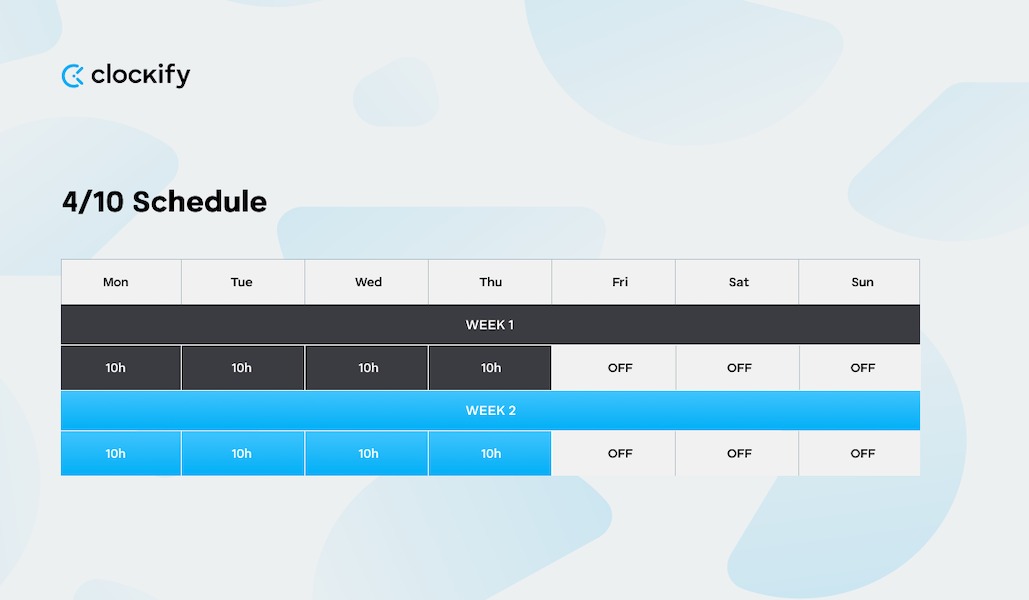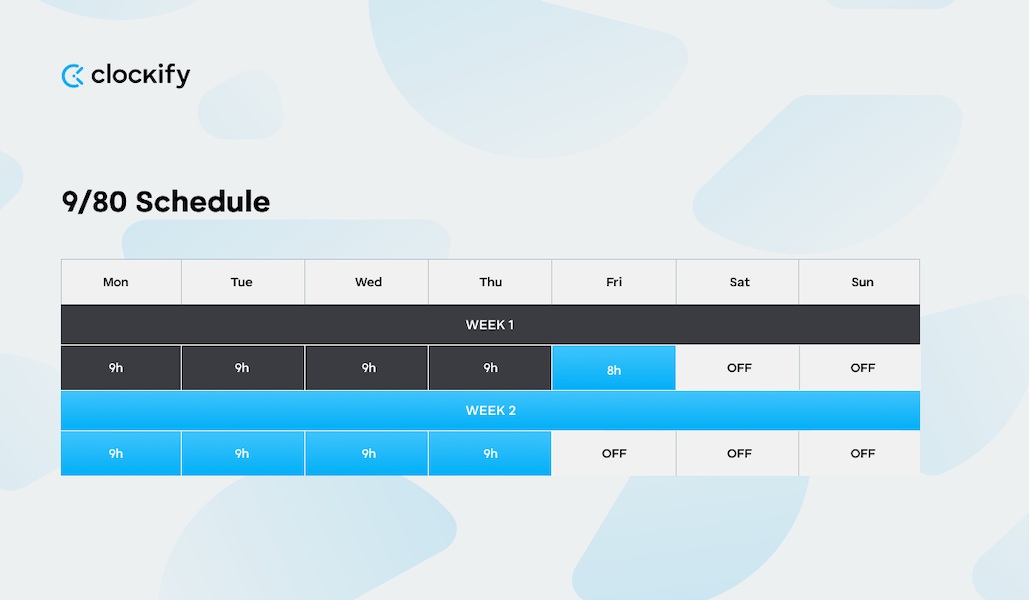Have you ever considered introducing a compressed workweek at your company?
If the answer is yes, there may be concerns holding you back from making the change.
Of course, you first need to determine whether a compressed work schedule is beneficial both for your team and your business.
That’s why we’ve prepared a detailed overview of a compressed workweek, the pros and cons that come with it, and actionable steps to make it all happen.

What is a compressed workweek?
A compressed workweek means employees are compressing more work hours into fewer days.
The aim behind the compressed schedule is for employees to have more free days in a week without impacting the workload.
It’s important to note that a compressed workweek has fixed hours and shouldn’t be mixed with flexible working hours. Simply put, flexible working hours imply the employees decide when to start and end their workday.
Now, let’s look at the most common compressed workweek schedules.
The 4/10 compressed workweek system
In this schedule, employees compress 40 hours into 4 days instead of 5 days. This results in 10-hour workdays and a 3-day weekend. The 4/10 schedule is most commonly used in offices.

The 9/80 compressed workweek system
In the 9/80 schedule, employees spread 80 working hours over 9 working days instead of 10.
For example, you might work 9 hours from Monday to Thursday and 8 hours on Friday. The following week, you work 9 hours from Monday to Thursday and have a Friday off.
💡 CLOCKIFY PRO TIP
If you’re interested to learn the number of hours you work per year and create a better work-life balance, read the following blog post:

The 2-2-3 compressed workweek system
This type of schedule is usually seen at healthcare facilities. The employees work 2 12-hour shifts, then have 2 days off, followed by 3 12-hour shifts.
Throughout the year, employees on a 2-2-3 schedule will have 180 shifts, compared to the 260 shifts on a standard schedule.
However, this system is limited mainly to industries like healthcare, call centers, and other lines of work that offer 24/7 coverage.
💡 CLOCKIFY PRO TIP
Don’t forget to check up on your healthcare employees — chances are some already experienced burnout symptoms. Read more about it here:

Pros of a compressed workweek schedule
Let’s explore the benefits of working a compressed workweek schedule.
Pro #1: An extra day off
The most obvious advantage — and the main reason why a compressed workweek exists — is an extra day off.
When you work 10 hours a day for 4 days straight, you earn yourself a well-deserved 3-day weekend.
A prolonged weekend leads to increased physical activity and better sleep. This is according to empirical research about extra time off conducted at the University of South Australia.
Almost like a mini vacation every week, right?
💡 CLOCKIFY PRO TIP
While we’re on the subject of time off, read more about different types of leave employees may have:
Pro #2: More quality time with your family and friends
An extra day off during the week opens up plenty of new opportunities. For example, you get to spend more time with your loved ones.
Whether you’re traveling somewhere or simply enjoying everyday activities, the important thing is that you’re together.
Pro #3: More time for running errands
When you have a day off for all the errands, even the dentist’s appointment can be a pleasant experience.
With nowhere to hurry, no meetings to attend, and no emails to check, you can take your time to:
- Visit the bank,
- Go to the hairdresser’s,
- Stop by the post office, or
- Do your grocery shopping.
And you’ll still have the rest of the day to relax without any scheduled work.
Pro #4: Less time spent commuting
How many minutes a day do you spend commuting to work? Is it more or less than an hour?
According to a study about car and public transport commuting, an average car commuter in America spends 25.4 minutes commuting. For the public transport commuters, this digit reaches 44.6 minutes.
And that’s just one direction per day. As a result, skipping even one day of commuting can save you an hour and a half.
Pro #5: More opportunities for deep work
When you know you have about 10 hours ahead of you, immersing yourself in work becomes easier. You remove all the distractions and just dive into projects with more motivation.
But, if you struggle to stay productive, choosing the right productivity technique to maximize results is a good idea.
💡 CLOCKIFY PRO TIP
Read the following blogs to get a better idea of which productivity technique works best for you:
Pro #6 Fewer absences requests
When employees have an additional day off for their personal life, chances are they won’t need to get out of work to run errands.
They can schedule bank or doctor appointments on their day off, reducing the need for absences.
However, these absences shouldn’t be confused with excused absences, which employees are entitled to.
For illustration, an excused absence can occur due to:
- Emergencies,
- Blood donation,
- Severe weather conditions, or
- Attending public ceremonies.
The number of excused absences for a compressed workweek is equivalent to the number of fixed hours the employee has.
Cons of a compressed workweek schedule
Here are the cons of a compressed workweek schedule.
Con #1: You may experience burnout
Long working hours can be tiresome and affect productivity, especially in the long run.
Although the first few weeks or months may be near perfect, employees can get tired and overworked once the initial enthusiasm wears off.
In the words of creative director Abhi Madan, burnout is a major drawback to a compressed workweek schedule:

“In my experience, the biggest downside is the potential for burnout as employees might push themselves too hard during the longer workdays.”
💡 CLOCKIFY PRO TIP
Learn how to recognize symptoms of burnout in your employees, so you can take action and prevent it:
Con #2: Your working hours may be incompatible with childcare facilities’ business hours
The beginning and end of your workday can be incompatible with the time your kids spend at childcare facilities.
For example, you may be able to get children to kindergarten in the morning — but you would need someone else to pick them up and look after them afterward.
Additionally, if employees work from home with their children present, the atmosphere can overwhelm both the children and the employees.
Con #3: Your business partners may not work at the same time as you
Business partners may not have the same schedules, so meetings may have to be postponed.
The same goes for contractors and clients. Before introducing a compressed workweek schedule, make sure you’re on the same page with everyone you do business with.
Con #4: Your company might become understaffed
Understaffing can become an issue as the workload increases on days off.
A simple solution to this would be hiring more people. However, this comes with a financial cost that employers may not want to take.
In industries like customer service, there must be enough employees to cover all the shifts and respond to customer’s queries.
Tips for working a successful compressed workweek
A compressed workweek schedule is used worldwide, and here are proven strategies to make it work.
Tip #1: Set clear goals and deadlines
Defining goals is the foundation of a successful compressed workweek. The focus must be more on results and less on hours put in.
Once you know what needs to be done in a week, you can set realistic deadlines and work towards accomplishing them.
The most effective way to do this is to create projects and break them into specific tasks.
Estimate the hours you need to accomplish a certain task, and you’ll find it easier to organize your compressed schedule workload.
💡 CLOCKIFY PRO TIP
Setting goals yields better results when you know exactly how to do this — read more here:
Tip #2: Have open communication with your team
Clear communication is the key to balancing personal and professional life.
Technology executive Javier Muniz emphasizes that communicating with your team and understanding their work and private lives are crucial for a successful compressed workweek:

“My #1 tip for a successful compressed workweek: Regularly check in with your team. It’s vital to keep lines of communication open, understand their work-life balance, and ensure they are not feeling isolated or overly stressed.”
Tip #3: Organize breaks smartly
One of the biggest enemies of a 3-day weekend is burnout. That’s why your main goal should be to organize breaks that provide real rest.
So, leave your phone and other electronic devices aside during the break.
For the maximum benefits, look at something green to increase your focus and enhance creativity. In other words, take a short walk in the park if there’s one close to your office.
Or simply stand by a window and let your gaze wander through the trees and sky. Take deep breaths, and try yoga exercises to shake off physical and mental tension.
💡 CLOCKIFY PRO TIP
Do you often forget to take a break during work? Read the following blog on how to track breaks to make the most of them (for yourself and your employees):
- Strategy for tracking breaks
Tip #4: Check up on progress and change the schedule if necessary
When working on a compressed workweek schedule, every week counts. At the end of each week, check if your employees are too tired or overwhelmed.
At the end of each month, organize an official meeting to review the progress made with your team.
If things aren’t functioning properly after the initial adaptation period, going back to a traditional schedule might be the best thing to do.
IT manager John Thompson says that individual preferences and job requirements seal the deal when it comes to the longevity of compressed workweeks:

“The longevity of a compressed workweek schedule largely depends on individual work-life balance preferences and job role requirements. In my team, we’ve seen about 60% stick with the compressed schedule, finding it beneficial for the increased consecutive days off.”
Make a compressed workweek schedule work for you with time tracking software
Shifting from a traditional to a compressed workweek schedule is possible — with the right organization and tools.
A user-friendly time tracking software like Clockify lets you fast-track your way to success for the most productive compressed workweek.
Here’s how:
- Schedule creation is easy, and your employees will never miss their compressed shift due to confusion,
- Time tracking will help you not to assign more hours than legally allowed,
- Report section will help you draw conclusions about the efficacy of a compressed workweek, as you can monitor time spent on projects and specific tasks, check billable hours and cost, and more.

Finally, the best part is that Clockify is suitable to use in any industry you can think of.
You can customize terminology and requirements to fit your needs, whether you’re in healthcare, construction, or any other field.
Don’t miss the chance to give your employees a 3-day weekend.


